As we jump on the bus from the road outside the elephant reserve (near Dambula), to go North into Tamil country, we are conscious that it is a newly-gained privilege to travel in this part of Sri Lanka.
Not long ago, travel throughout the war torn island was constrained either by governmental rules and police action, or by the sheer danger of traveling through hot spots of the decades long civil war, which ended in 2009.
We have travelled enough to appreciate that to any national conflict there are various strains of truths and experiences, and that there is never ONE history, but rather multiple histories that cohabit.
The multi-lingual, multi-cultural, multi-ethnic and multi-religious population that makes up Sri Lanka, is both a tremendous asset, a potential source of pride and a historical heritage which has come with a share of political complexity.
What most Westerners know of Sri Lanka typically comes down to two historical data points:
It used to be called Ceylon (and was a colony of the UK) and secondly, the Tamil Tigers waged a civil war.
Let’s add a bit more color:
In the 13th Century, Marco Polo called Sri Lanka the finest island of its size in the world. Over several centuries after Marco Polo’s accounts, European and Arab traders were lured by a plethora of spices, precious stones, elephants and white sandy beaches.
The subsequent European Colonialist dance played out in Sri Lanka as it did in so many parts of Asia, with several sequential empires trading place as Colonial overlords, between the Portuguese, then the Dutch and then the British…
While Tamils have inhabited Ceylon for two milleniums and this community deserves to be considered as much of an indigenous population as the Singhalese population, there is a common misperception (ours as well, as you can read from a Tamil reader’s comments below) that it was the British who planted the seeds of current day conflict by bringing “foreign” labor from other part of the British Empire, who spoke a different language ~ Tamil ~ and had different cultural and religious practices (Hindu, Muslim)
We are eager to experience first hand this Tamil tapestry, and start the process of adding granularity to our historical and cultural experience of Sri Lanka.
There are multiple former hotbeds of Tamil versus Singhalese conflict. We hesitate between going all the way North to the formerly grand city of Jaffna (hit particularly hard during the civil war) or East to the port city of Trincomalee.
Neither of these places are typical tourist destinations (as of yet) but both of them have scores of fans, as we start to discover when Peta asks Sri Lankans what their recommendations are, for venturing into Tamil country.
We really want to visit both; but this time, we need to select one, due to time constraints. Jaffna is way up at the Northern tip of the country, (a mere ferry ride away from Southern India)… Trincomalee is said to have some of Sri Lanka’s best beaches and landscapes.
And so, we select Trincomalee as we are huge fans of wild and undeveloped beaches; We also want to be in a position to travel down the Eastern coast of Sri Lanka.

This is a cool map of Sri Lanka, because you can visually see the little icons of elephants indicating how many reserves there are, as well as heritage sites. The blue ovals indicate our route from Colombo in the West to Dambula in the center and on to Trincomalee on the East.
When we get off the bus, the first feeling upon arrival in Trincomalee is that of being parachuted into the colorful streets of small town India.
Suddenly women are wearing bright saris, and all the men are wearing colorful sarongs. Buddhist temples from the South have given way to Hindu temples, in all their psychedlic 3 dimensional splendor. We instantly feel excited and very comfortable.
Before taking a tuk tuk to find a place to sleep for the night, we mingle into the hustle and bustle on the streets, enjoying the experience of being in a new and interesting place. We have definite shades of being back in Pushkar and Kochin, India.
Behind the street with small shop fronts, we see the tall colorful spires of a Hindu Temple rising up into the blue sky. A pantheon of Indian gods and mythical creatures beckons us.
Whereas in India entry into HIndu temples is forbidden to non Hindus, in Trincomalee, we are welcomed to enter into the holy temple and sit in on the ceremonies which are taking place. (Perhaps those who have been rebuffed at Indian temples will appreciate the inclusiveness and rare opportunity this offers…)
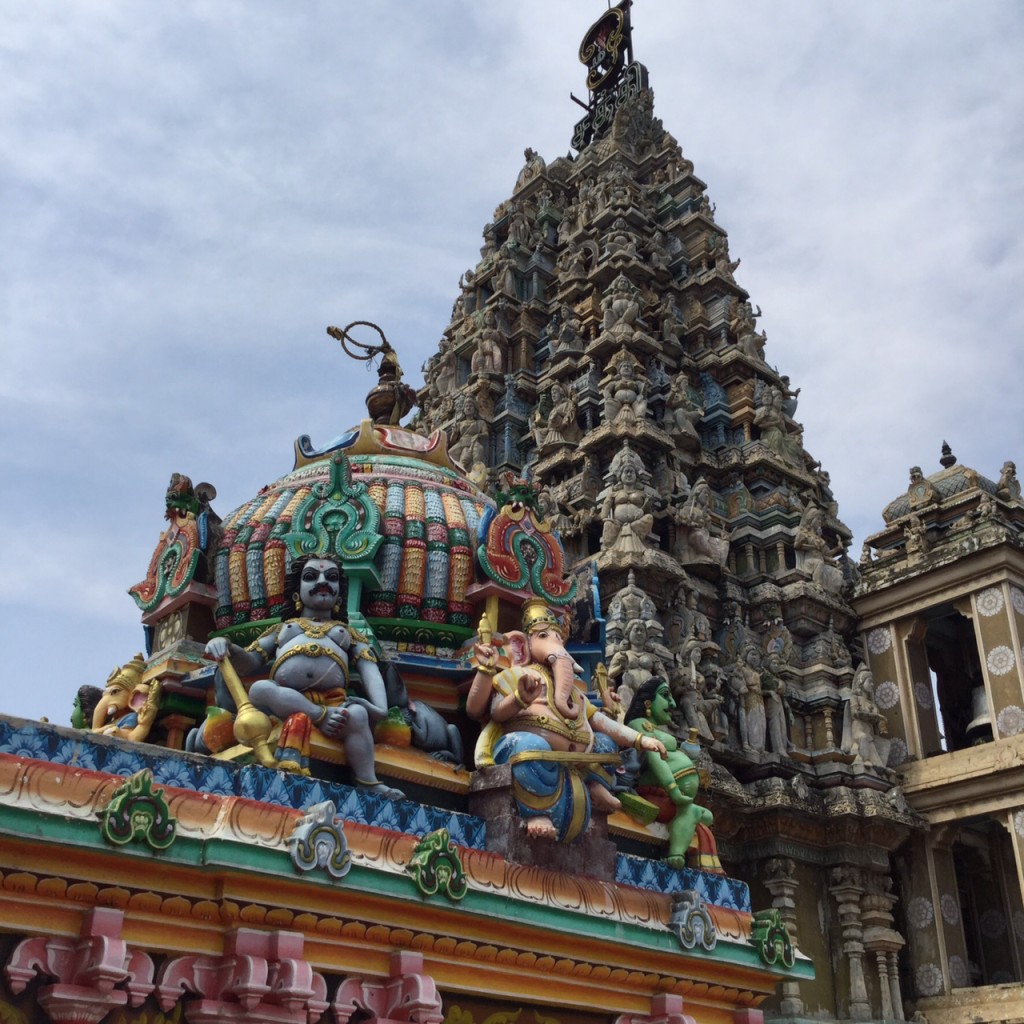
Hindu Temple in center of Trincomalee with its spire and deities.
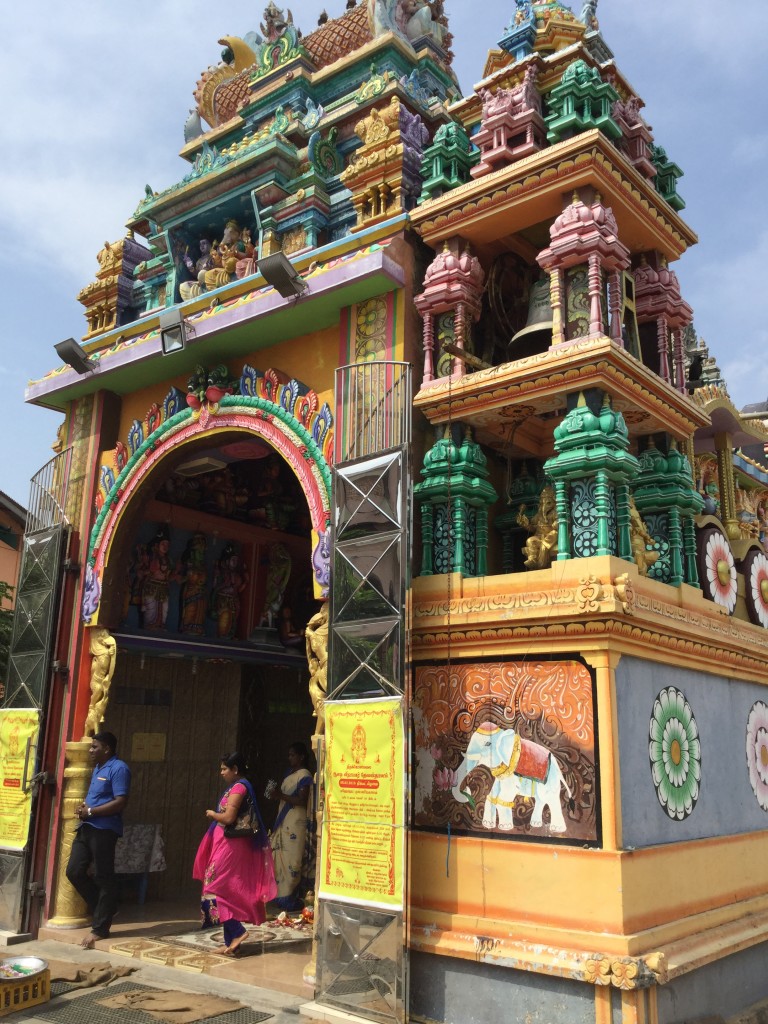
Brightly colored and decorated entrance to the temple.
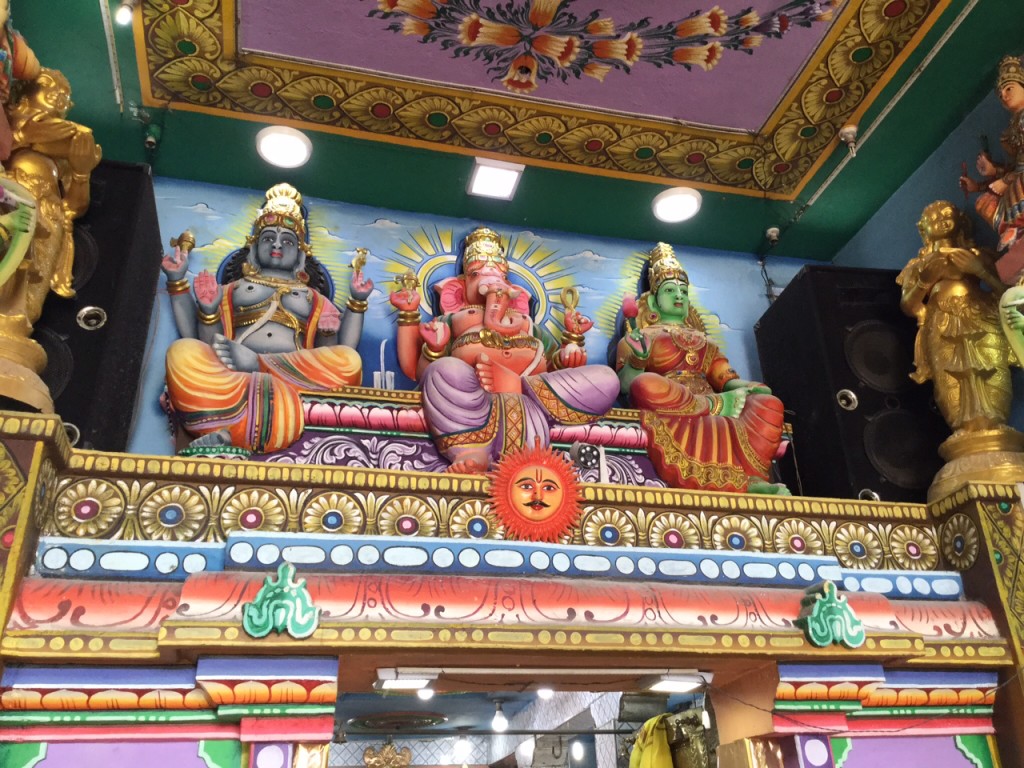
The gods are omnipresent both outside the temple and inside above the shrines.
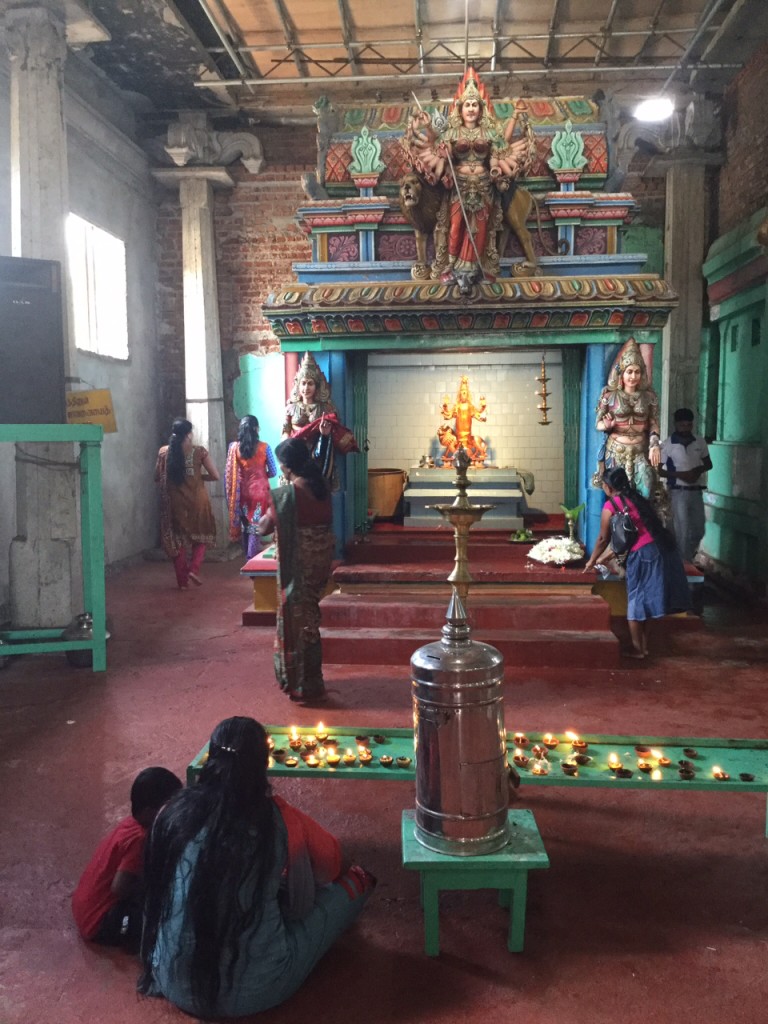
The ceremony is a vibrant activity with the constant ringing of bells, beating of the drums and high notes of an Indian wind instrument.
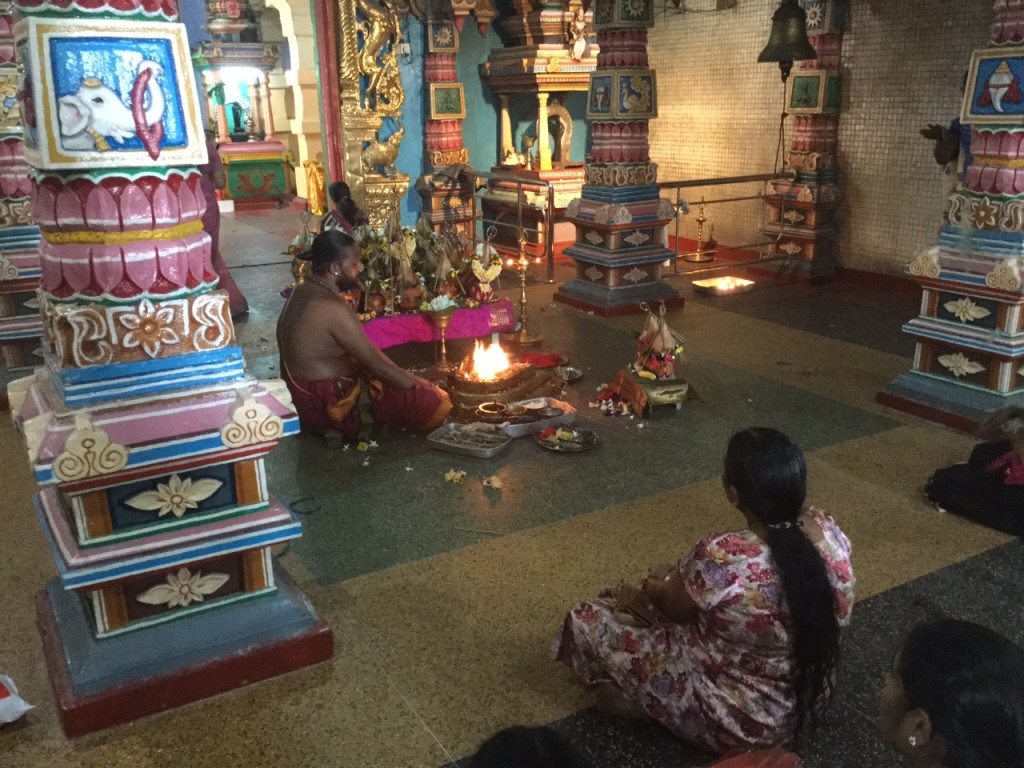
In India we lived for a month right next to the sacred lake in Pushkar: the sounds and sights are very familiar to us.
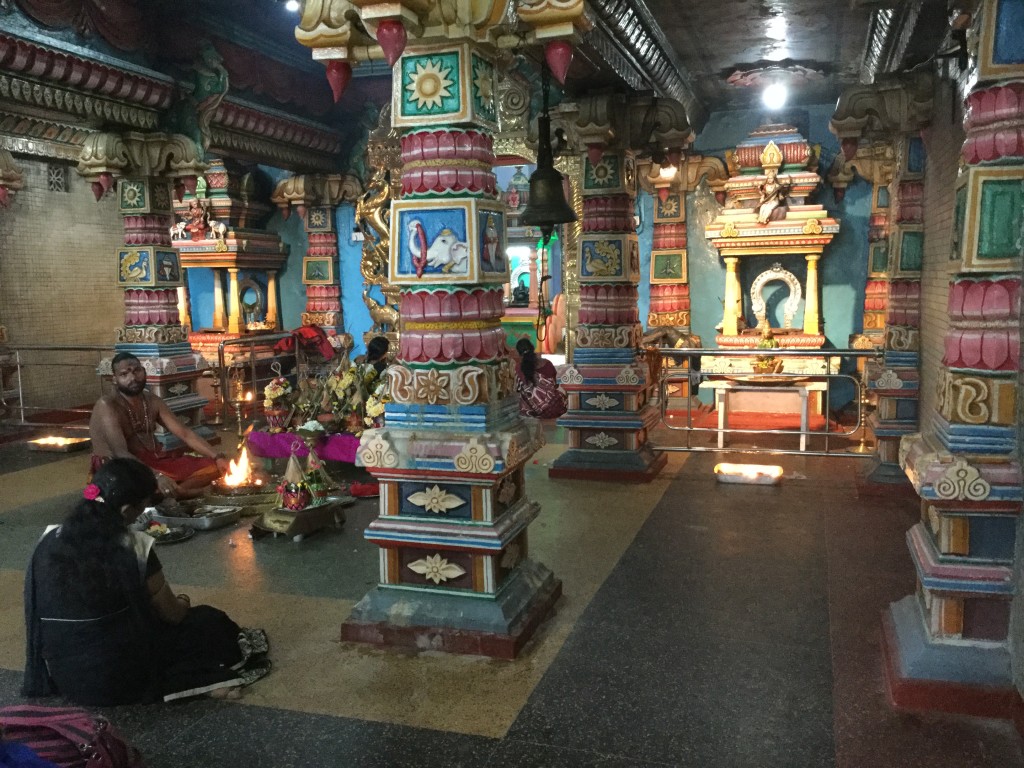
We quickly discover a core element to understanding the Tamil/ Singhalese conflict. Tamil is not a religious nor ethnic grouping. It is a linguistic grouping. Some Tamils are Hindu, some are Muslims, some are Christians. Religion is not a divider in Tamil country.
We learn from talking with multiple residents of Trincomalee that the fighting here was extremely harsh and that the Tamil Tigers had taken possession in the nearby jungle. Trincomalee was the scene of repeated bombing campaigns by both sides — the Singhalese Government and the Tamil Tigers, with the Trincomalee population caught in the middle.
There are remnants and hints at the power relationship between the two populations. For instance, all the policemen which are more visible around town than in the South, are Singhalese and more often than not, do not speak Tamil. (Classic case of setting up an adversarial relationship between the government and a linguisticaly and culturally different region.)
After our temple immersion we hop on a tuk tuk to go in search of accommodation and a place to drop our backpacks so we can be unencumbered. Our criteria is to be on the beach.
On the way we do not pass up the opportunity to have a regional chapatti bread being made street side, as breakfast has only been bananas eaten in the back of a jeep while elephant watching in the reserve at dawn, hours ago.
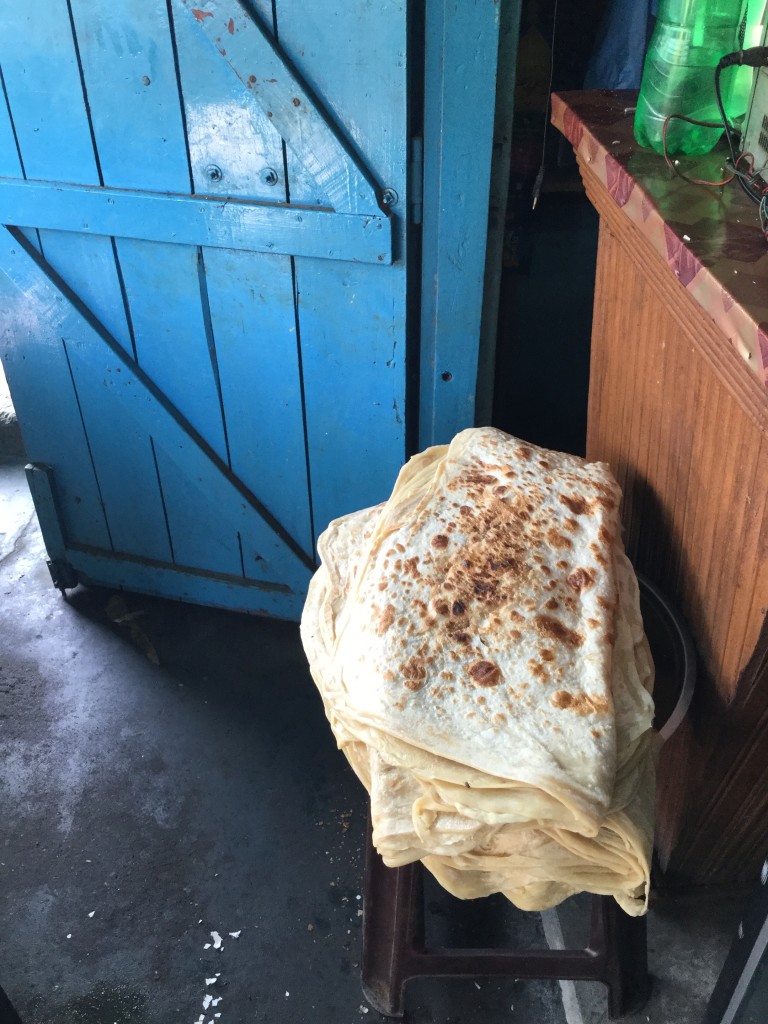
A pile of freshly made Roti (also known as chapatti), an Indian flat bread made from stoneground wholemeal flour, piled up in a small store front on the street.
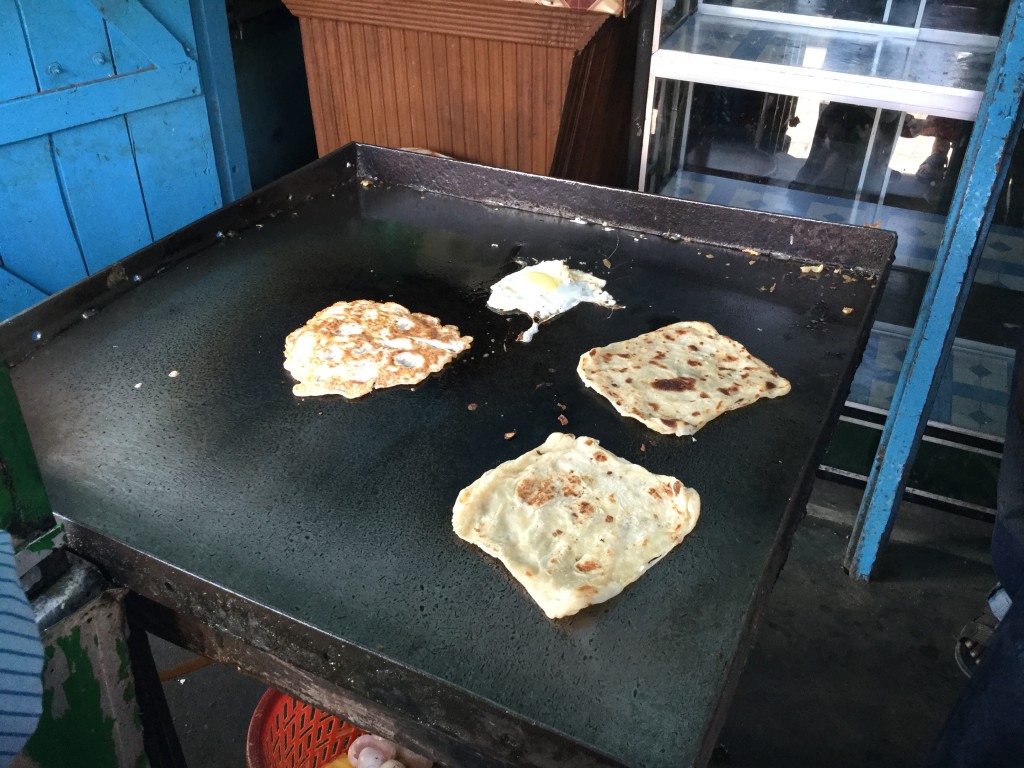
Roti (flat bread) on the griddle.
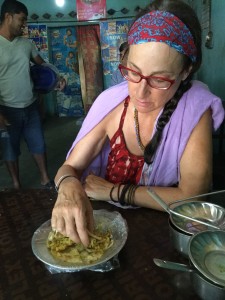
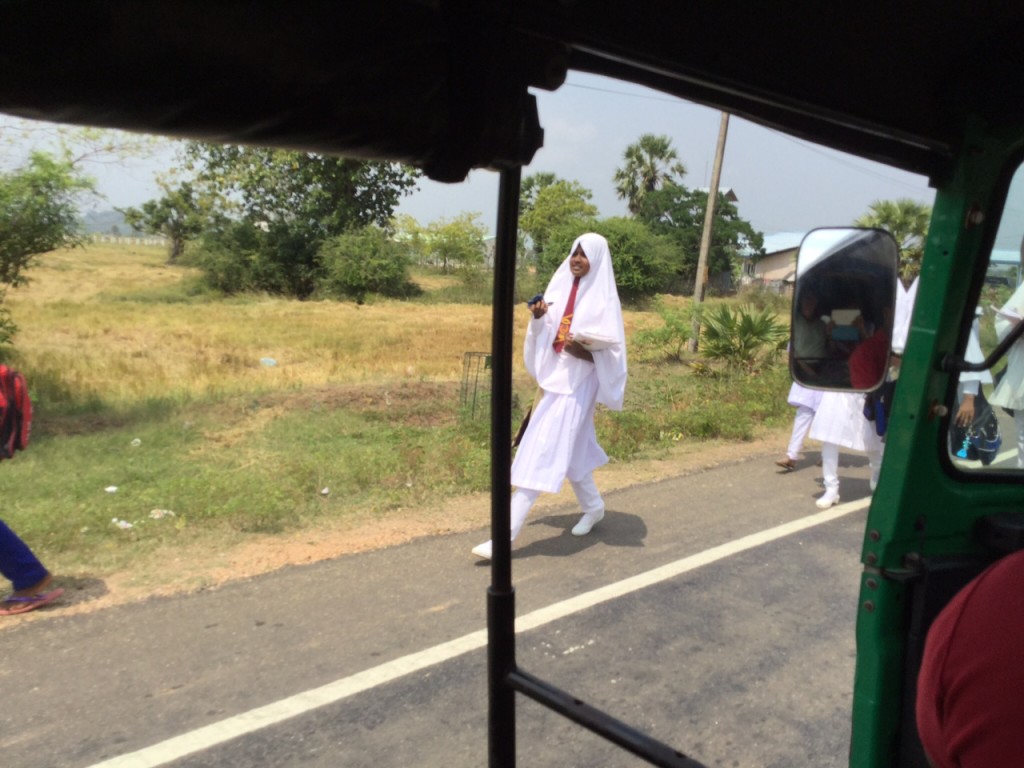
We pass through a predominantly Muslim neighborhood, with a group of schoolgirls all wearing white hijabs.
Along the beachfront, there is a handful of other Western travelers and the rest of the visitors are Sri Lankan families who have come to the beach for a weekend getaway.
The hotel we find probably had its grander days, yet it still maintains a feeling of an old fashioned hotel by the sea. (Not very different from places that I (Peta) recall from my childhood with my grandfather in Muizenburg, at the coast in South Africa.)
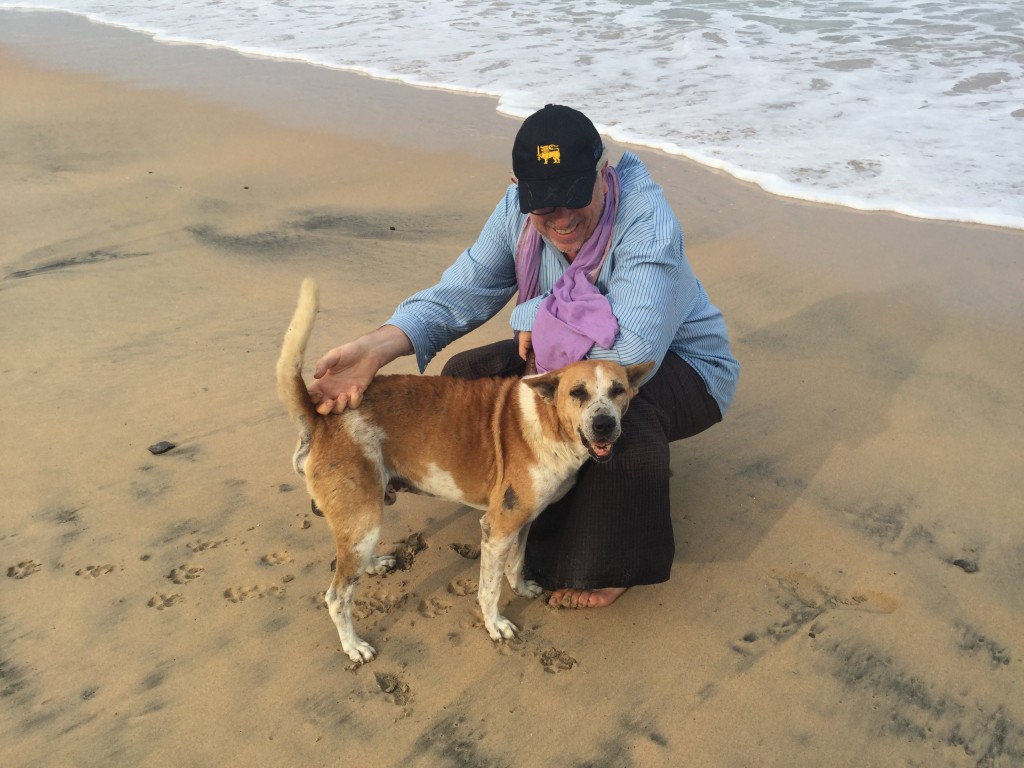
Ben befriending a stray dog on the beach. (No matter where we are we make animal friends.)
The beach is long and wide and we quickly befriend a large Tamil family. They are eager to converse with us as foreigners, and clearly this is a first for them! Luckily one of the daughters of three matriarch sisters, is an English teacher and she rises to the challenge. They have many questions for us, as we do for them.
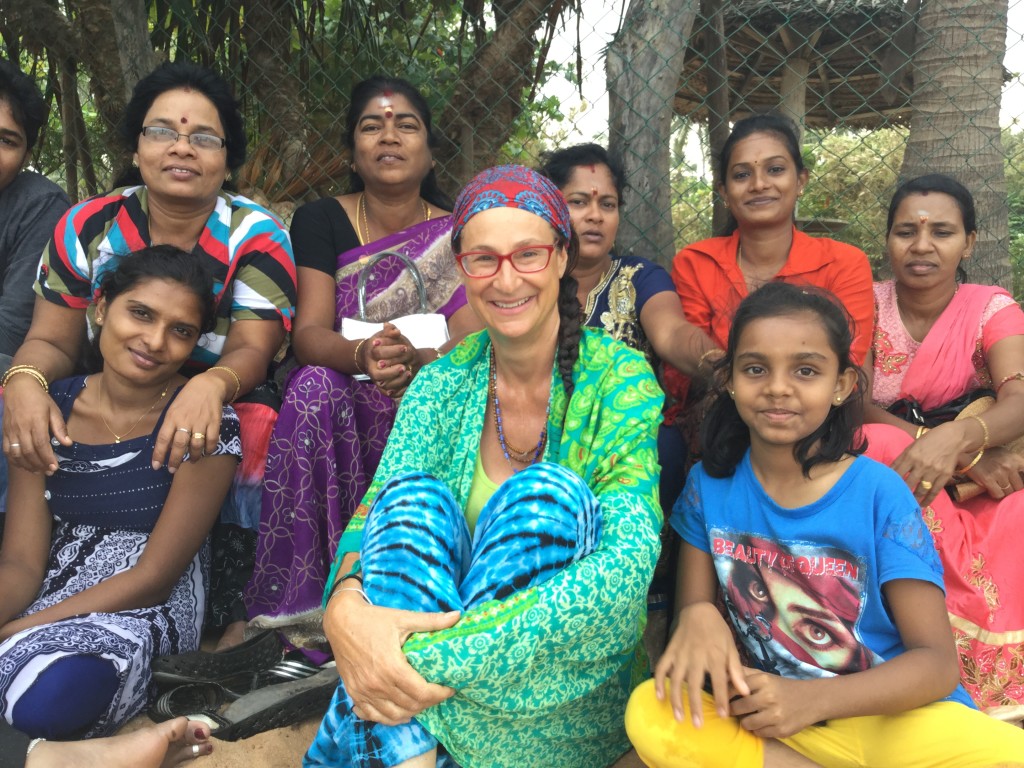

Enjoying the beach with newly made friends. (Three sisters and their children.)
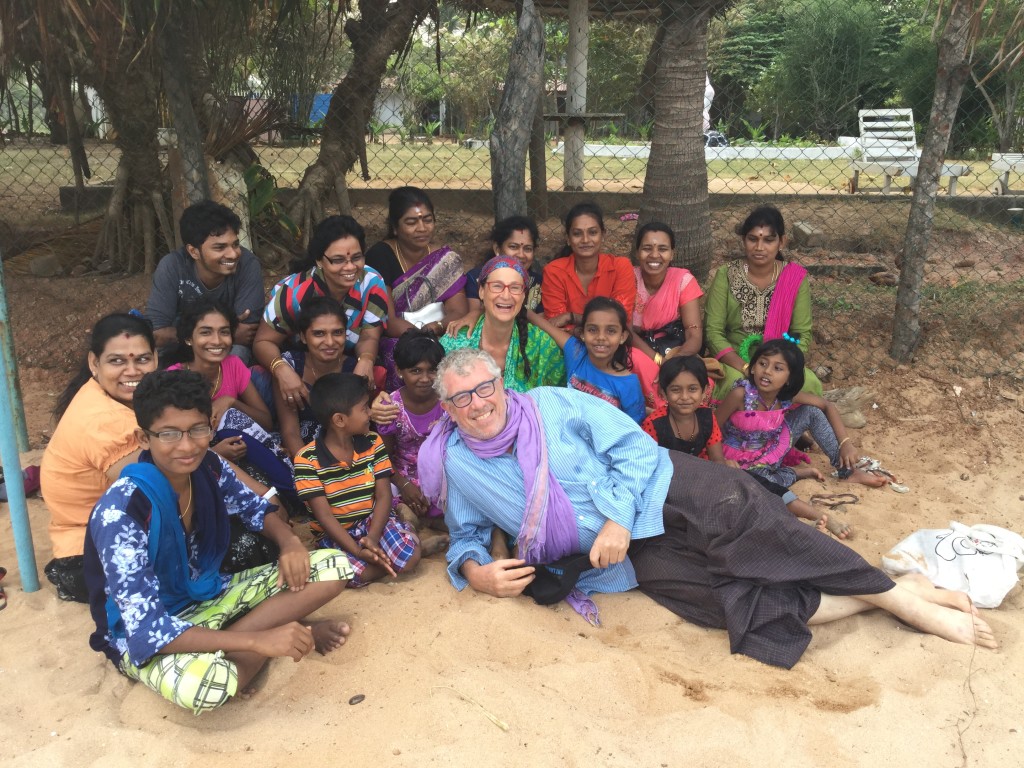
We take lots of pictures, they take lots of pictures…. We all have a good laugh together!
After a few hours on the beach, we are in search of a tasty bite to eat. We discover that the only options available within walking distance are curry and rice, or…. curry and rice, and so we look for a tuk tuk and head into town in search of some good seafood (which we find.)
We discover a network of parallel alleyways that connect from a main street, to the sea front ~ creating numerous micro neighborhoods inhabited by fishermen and their families.
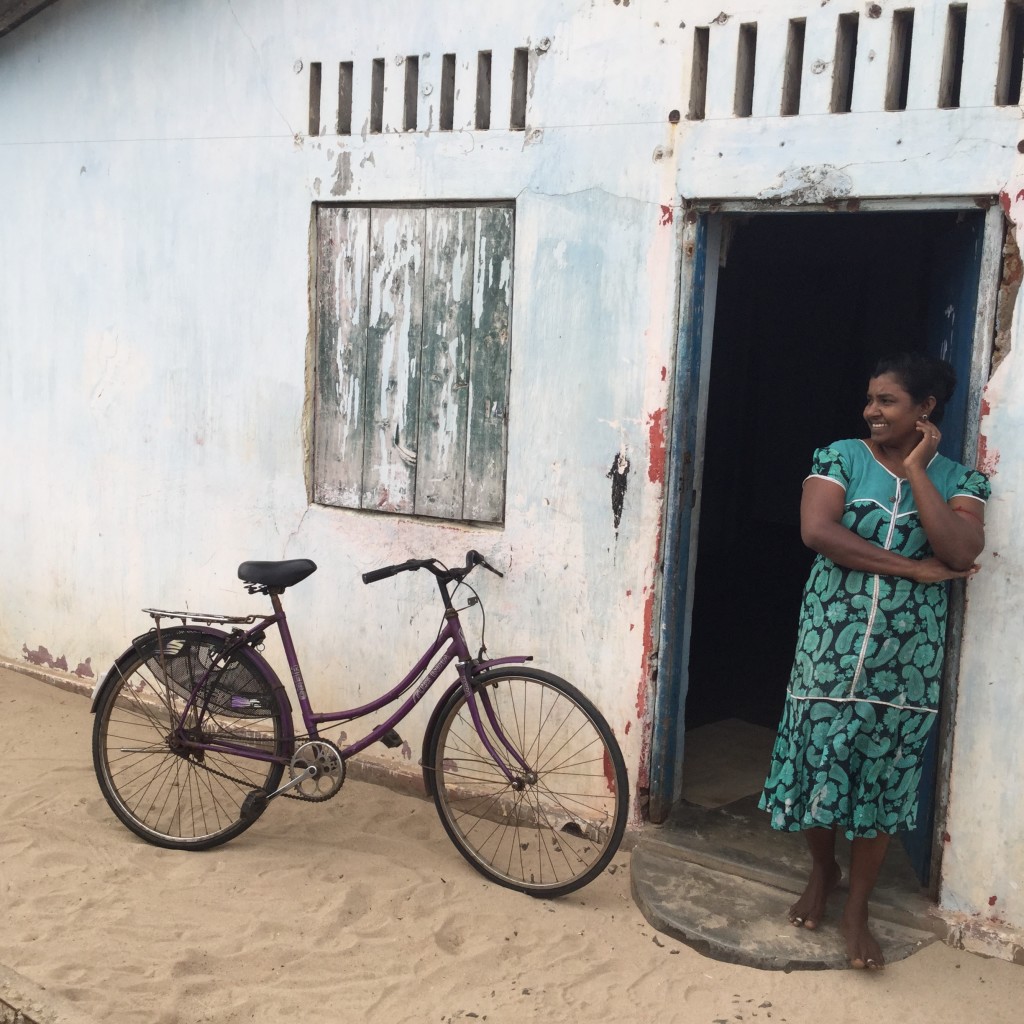
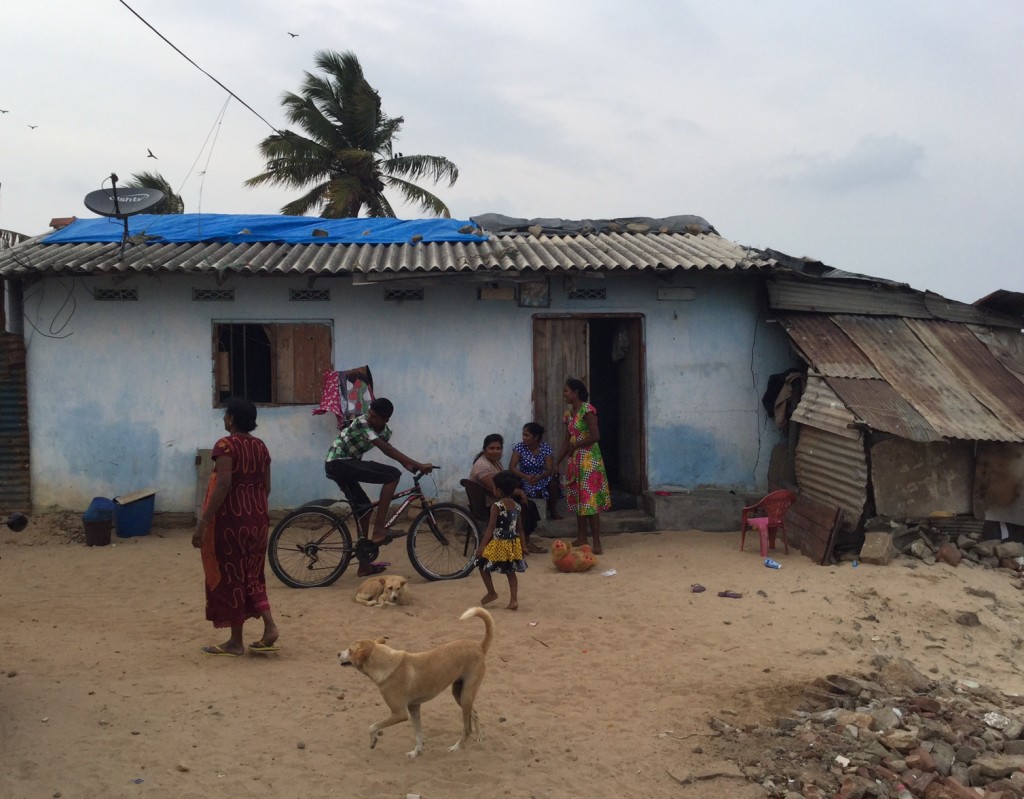
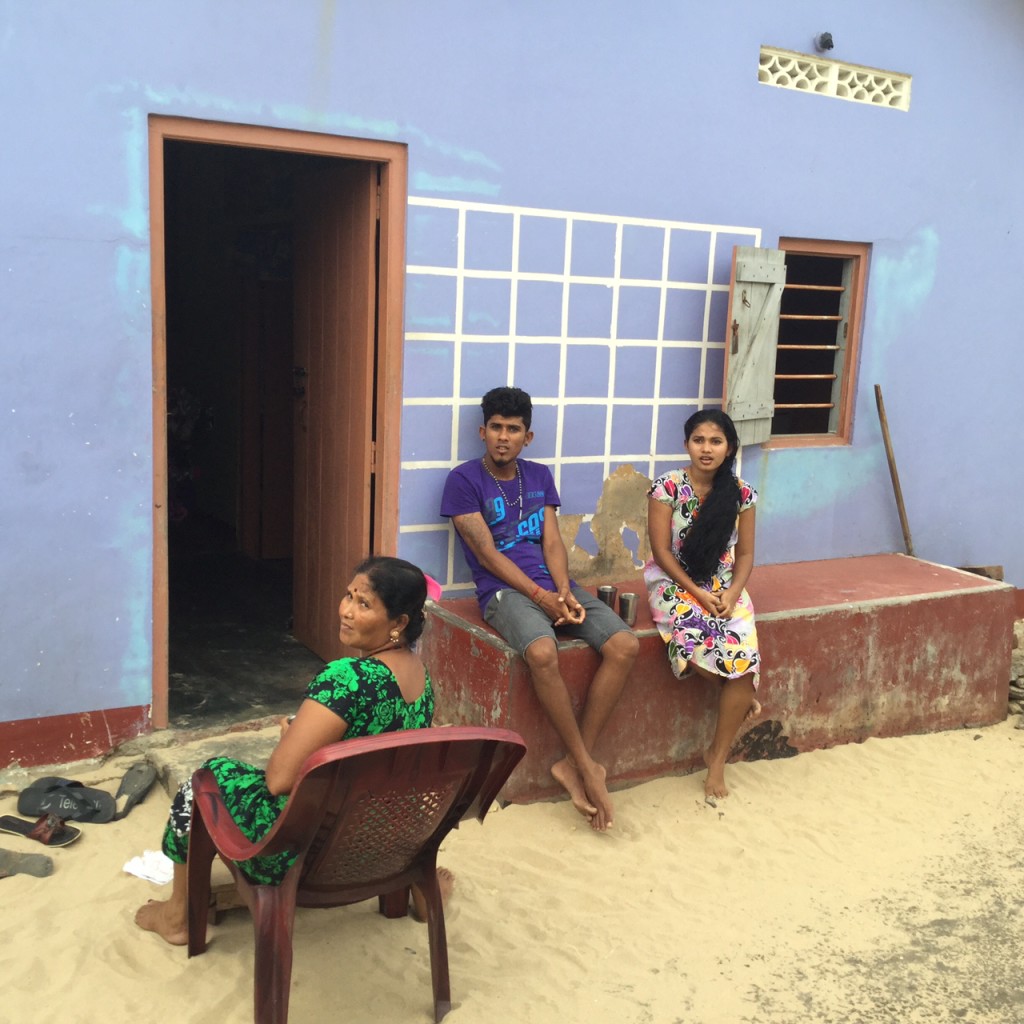
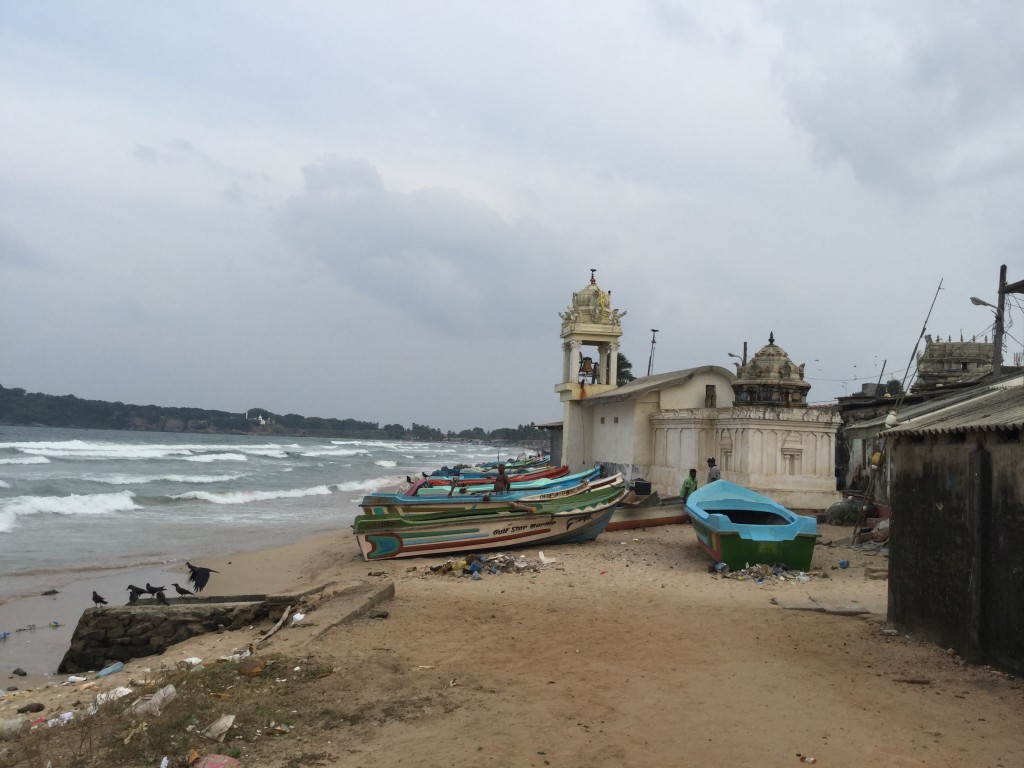
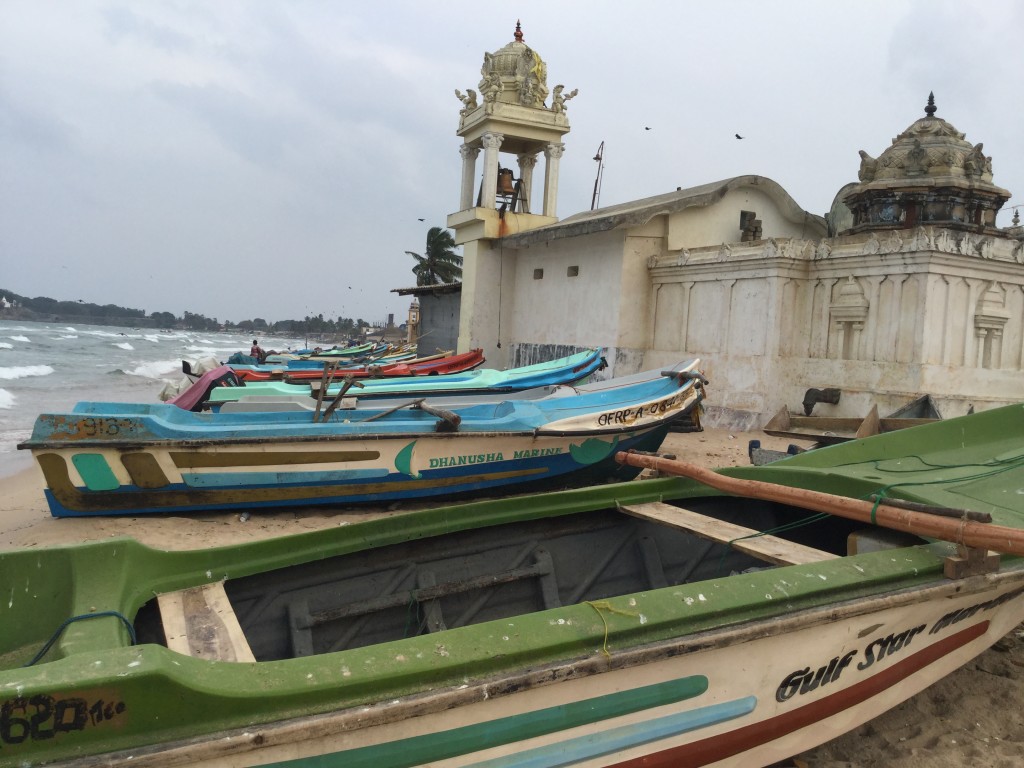
Trincomalee is an eye opening window into Tamil country ~ The colorful buzz of street life will remain vibrant in our minds, as will the feeling of warmth and friendliness offered up by the locals.
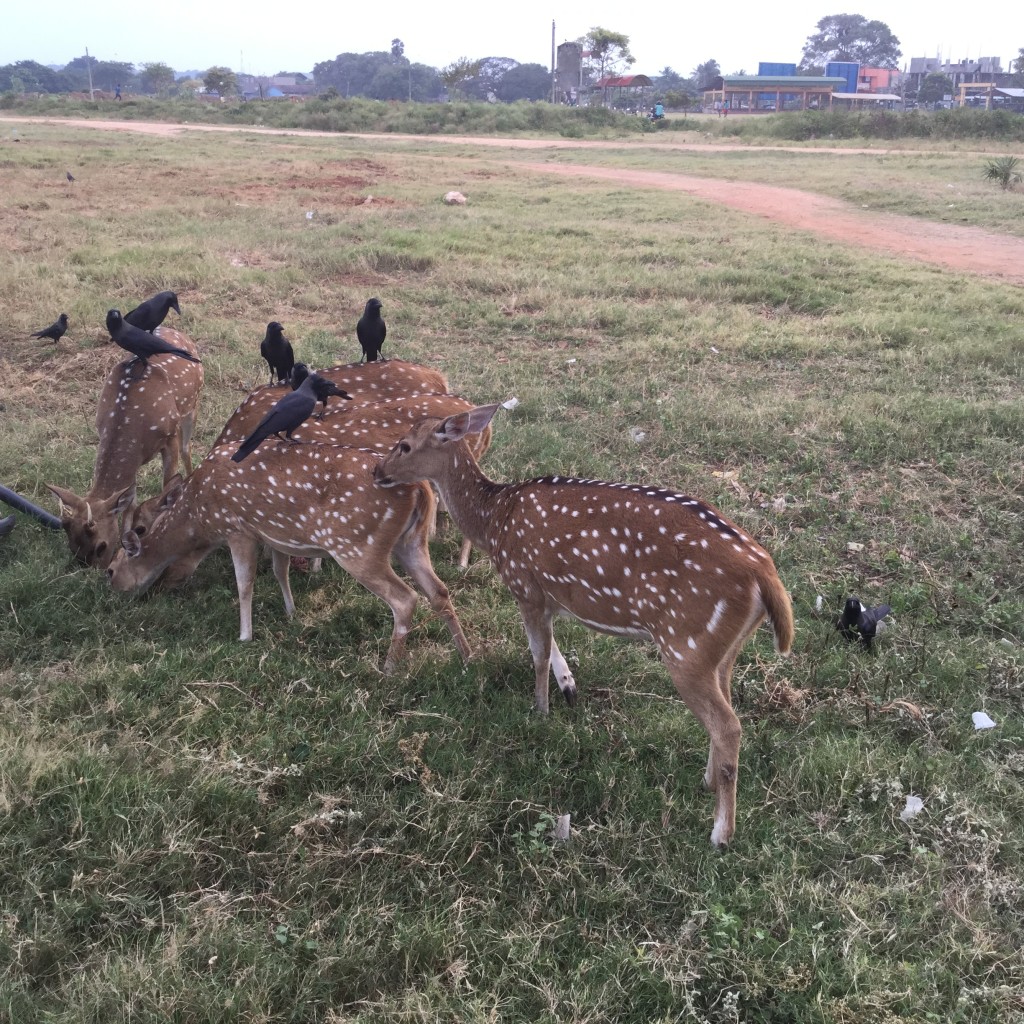
Groups of spotted deer on the side of the road is not an uncommon sight in Trincomalee.
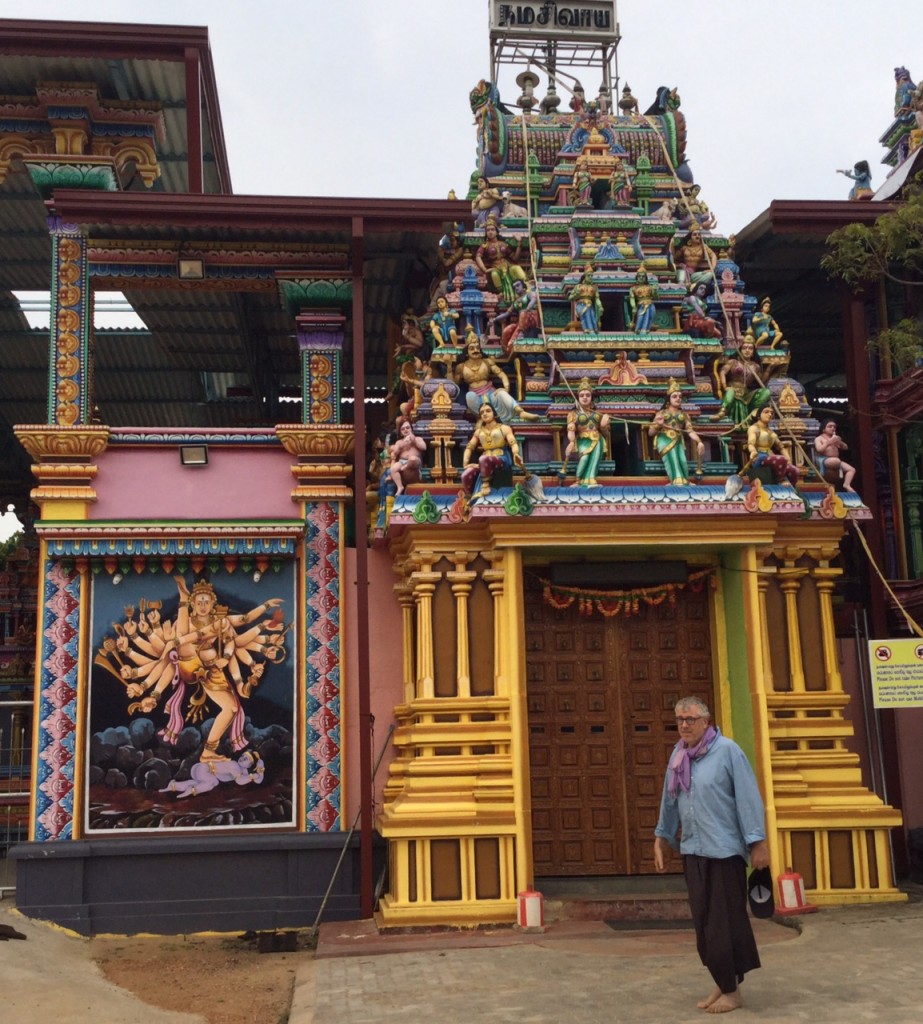
Koneswaram Temple: A classical-medieval Hindu Temple complex, a religious pilgrimage center in Trincomalee it sits atop a hill overlooking the ocean.
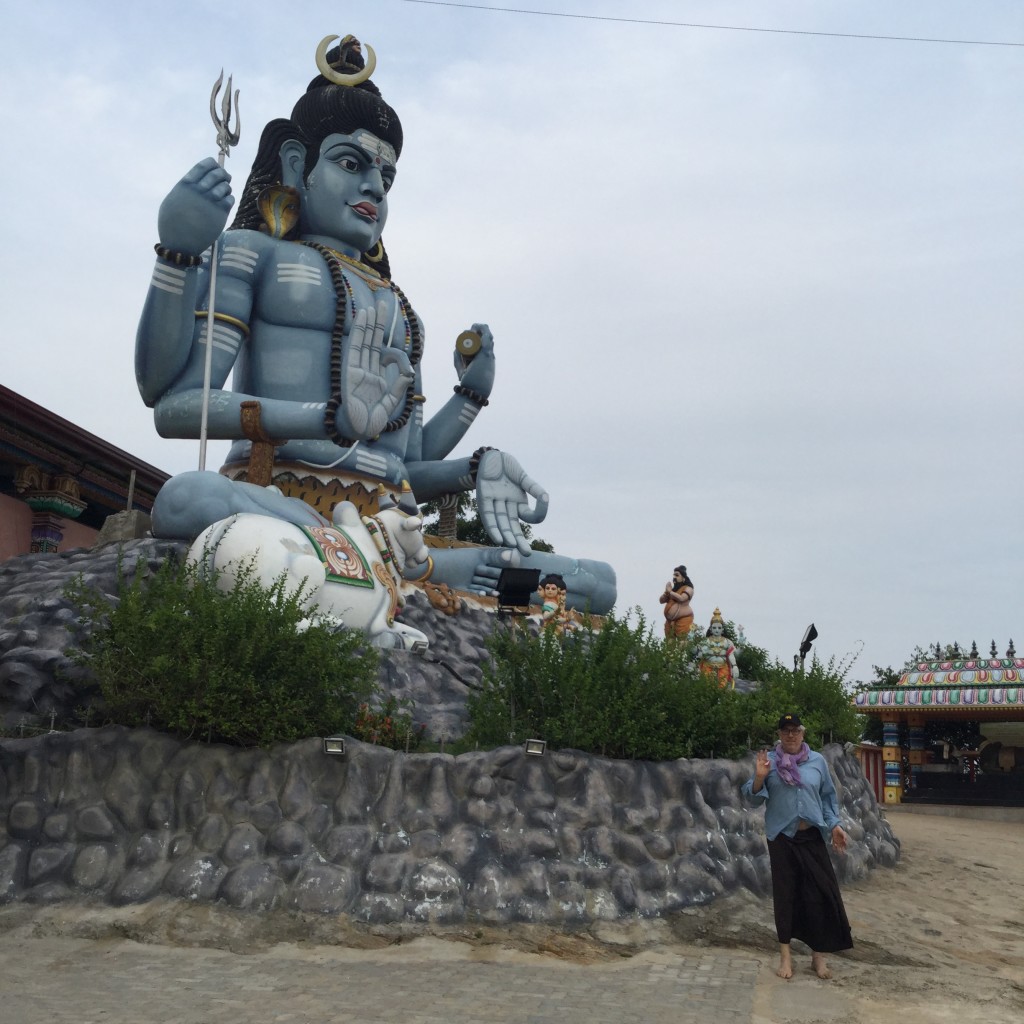
A huge statue of Shiva at Koneswaram Hindu Temple. Ben is in front giving an idea of the scale.
~ ~ ~
Certainly, a few days in Tamil country starts to peel away at the easy labels, which are many. The Singhalese population in the South generally considers the Tamils to be “foreigners”!’; The government of Sri Lanka (and other governments) considered them “terrorists”; Many amongst the Sri Lankan Tamil community (As well as India’s Tamil Nadu population), considered them “freedom fighters”.
With regard to the Tamil people in Sri Lanka, we are just at the early stage of discovery of the intricacies of the complexity of the situation.
~ Origin of the Tamils : The Colonial British empire “sourced” labour from the Tamil Nadu province of India, also under British rule. It is this twist of history that the SInghalese point to when they claim that the Tamils are “foreigners”. In this sense, it has some basis in history. BUT… and THANK YOU to a Tamil reader of our blog, Jey, who corrected our overly simplistic historical summary with the following comments:’
“The original Tamil speaking inhabitants of north and east Sri Lanka have at least a two thousand year history on the island. The Portuguese and Dutch conquered the Tamil and Sinhalese kingdoms but ruled them separately. Please google Rob Morden Ceylon map and Sir Hugh Cleghorn 1799 on Tamils and Sinhalese inhabitants of Ceylon. It was the British who in 1833 decided to join the Tamil and Sinhalese kingdoms for administrative purposes.”
~ The Muslim Tamil population pretty much stayed out of the conflict reinforcing an image of Muslims as a peace loving community in Sri Lanka, (as we had started to discover in Fort Galle in 2014). The Muslim community here is Suni and does not recognize itself in the form of Islam that pervades Middle Eastern Politics
~ India’s Tamil Nadu population was an active participant in the civil war as a source of funding weapons etc. and this bit of history continues to stain the relationship between Sri Lankas Singhalese government and its mostly HIndu larger neighbor.
If you enjoyed this post, please follow Green Global Trek.
Comments and feedback are welcome and appreciated!
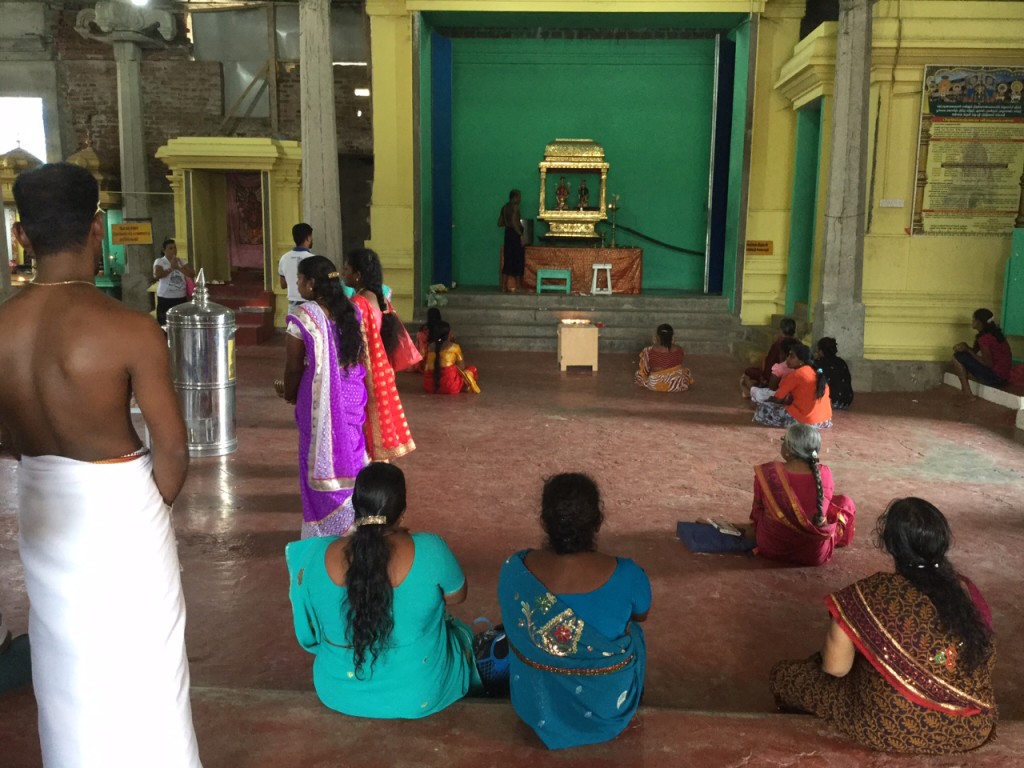
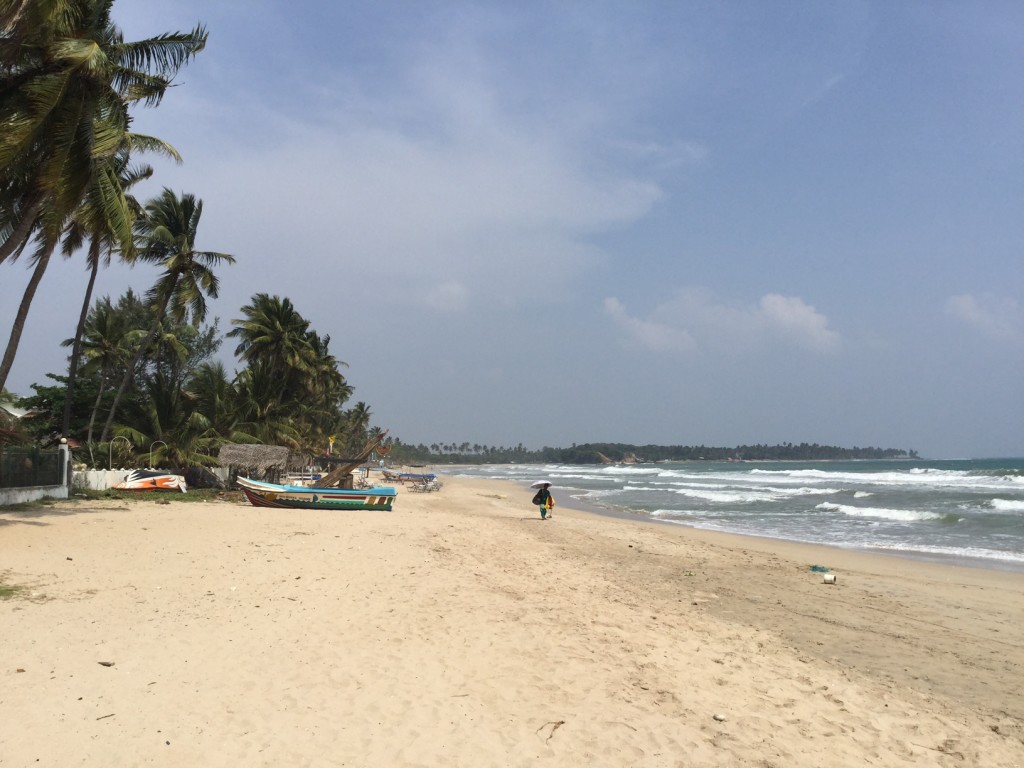
This is a great article guys!
Thanks Andrea, glad you enjoyed it. Nice to know you reading us.
Wow, a whole year has gone by since we met and had so much fun in Morocco together!
Sri Lanka sounds wonderfully complex, and I appreciate that your list of insights at the end is numbered 1,1,1. Gertrude Stein’s aunt is said to have counted this way, to keep things from adding up.
Thanks Sharon. It has been fascinating and interesting starting to understand the complexities of Sri Lanka and its history. It’s a small island, yet it ‘packs a lot of punch’.
Love the slice of history and truly appreciate the context as well as your beautiful writing and pictures. I need color in my world (it’s a gray day today and I’m dressed in my usual muted colors!) This is just the vicarious thrill I need! Enjoy, enjoy!
Thanks Ellyn for such positive feedback and glad you are enjoying our posts. Very happy to be the providers of color and vicarious thrills! Hoping sunshine comes your way very soon!
This is such a wonderful way to follow you in your traveling discoveries….Thank you for explaining the world wonders….
So glad you are enjoying. We often think about friends and family members who would most appreciate the areas and places we travel to. In that sense, you ARE traveling with us.
Hi I am a Tamil from Jaffna and I feel very hurt about your incorrect comments about Tamil history in Sri Lanka. The truth is that the Tamil labourers brought over by the British from India during the 19th century settled in the hill country in the south and central Sri Lanka and still work there on tea plantations. A million of them were disenfranchised by the Sri Lankan government after independence in 1948 and sent back to India. Only a few hundred thousand still live in Sri Lanka. However the original Tamil speaking inhabitants of north and east Sri Lanka have atleast a two thousand year history on the island. The Portuguese and Dutch conquered the Tamil and Sinhalese kingdoms but ruled them separately. Please google Rob Morden Ceylon map and Sir Hugh Cleghorn 1799 on Tamils and Sinhalese inhabitants of Ceylon. It was the British who in 1833 decided to join the Tamil and Sinhalese kingdoms for administrative purposes. By generalising all Tamils in Sri Lanka were brought over you are helping to deny our historical and cultural identity. Hope you understand. Thanks.
Jey, thank you very much for your comments and correction of our explanation of the Tamil people in Sri Lanka.
It appears that our initial understanding of the Tamil experience focused on the role the British played as you described and we did not yet appreciate the pre British centuries old lineage of the Tamil population in Sri Lanka. We trust you understand there is/was nothing malicious in our comments, and your comments are a sober reminder of how a little knowledge can be dangerous.
Your comments ring particularly true because we are Jewish, and people without sufficient historical context occasionally reach damaging conclusions with regard to the state of Israel, referring to the infusion of Jews from Western Europe in 1945-1948, ignoring thousands of years of Jewish presence in the land of Israel. It seems we have made a very similar error in reducing the Tamil presence in Sri Lanka to the “recent” British led introduction of Tamil labor on the island of Sri Lanka. We stand corrected and appreciate your input.
We are thrilled you are reading us and we will continue our education on the history of your people in Sri Lanka. This was our second visit to your beautiful country and we look forward to visiting Jaffna in December 2016.
We will add your comments at the end of our post, to properly reflect the historical accuracy you point out.
Sincerely,
Peta & Ben.
The story of the Tamils in Sri Lanka is interesting, thanks for sharing.
We know so little about the Tamils but are fascinated with the multicultural ancestral profile of Sri Lanka. We look forward to spending more time in the North and can’t wait to go to Jaffna.
Wow, what an interesting country with a very rich and complex history! It’s crazy to think about how little we know about other corners of the world. Definitely learned something with this post 🙂
Yay, we love this kind of feedback. We learn a lot as we discover new lands and enjoy providing vignettes of what we learn, through our blog.
So many countries, so much to learn….
Peta and Ben, I wish I were there with you!
I appreciate and admire your efforts to explore–and then share–the diversity of the culture of Sri Lanka. The pictures capture your openness to foreign experience, and your historical overview of the region provided well-rendered depth to your story.
Overall I was grateful to read this, since once again I felt transported to a place entrenched in history (it’s easy to forget that the US is still young and few people feel the weight of ancestry), and through the balance of your narrative and the surrounding context I felt able to capture the significance of your everyday interactions.
Julie thank you for your very eloquent comments.
Everday interactions with locals are, you are correct, inextricably seeped in historical and cultural precedent. The more we learn about historical context from the people themselves, the richer our interactions. This is for us, the very core of travel. No doubt you had a similar experience when you lived and danced in Yogyakarta, Indonesia.
Travel is also enriched when meeting fellow travellers with whom we have a natural good connection, such as when we met you, at the Buddhist meditation retreat in Chiang Mai, Thailand.
Your perspective of this region is so spot on (from what I know of my 48 hours visiting Trincomalee). We’ve been blown away by the color and the smiles. But we were introduced to the ‘conflict’ within 5 minutes of our arrival when I asked a Sinhalese Tuk Tuk driver offering his services how to say ‘Thank You’ in his language. He gave me a five-minute explanation of how the Sinhalese language is so much easier than the Tamil language and everything Sinhalese is superior to Tamil. This in the presence of a Tamil doctor who was on-board clearing us in for health (quarantine) and a Tamil employee of our shipping agent. Why can’t we just all get along? I was unaware that Muslim’s are considered peacekeepers here, but I can confirm that the Muslim’s we have met have been very gregarious and welcoming…. really, everyone has been. It is a lovely place.
Lisa, as we read this the multi-religious, multi-ethnic population of Sri Lanka is under severe test. Some politically motivated acts to try to foment tension between Buddhists and Muslims have created some havoc in Sri Lanka over the past days.
Your experience sadly is not unique. It seems that in most places in the world there is always a group that sees itself as superior and the others as underdogs. Never is it rational, and yet it keeps happening over and over again.
As foreigners in this land it is easy to disassociate from the complex cultural history of Sri Lanka and leap to the conclusion that everybody should get along, but of course that runs directly against human history. Hopefully all segments of the population here have reached the conclusion that the civil war was highly destructive and the best possible outcome would be to strive for unity and cross cultural acceptance.
Ben & Peta
It’s a pity you don’t have a donate button! I’d certainly
donate to this outstanding blog! I guess for now i’ll settle for bookmarking and adding your RSS feed to my Google account.
I look forward to new updates and will share this blog with
my Facebook group. Talk soon!